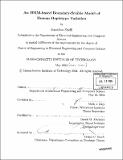An HMM-based boundary-flexible model of human haplotype variation
Author(s)
Sheffi, Jonathan, 1981-
DownloadFull printable version (4.012Mb)
Alternative title
Description of haplotypes and their ancestry structure from SNP data
Other Contributors
Massachusetts Institute of Technology. Dept. of Electrical Engineering and Computer Science.
Advisor
Mark J. Daly and David M. Altshuler.
Terms of use
Metadata
Show full item recordAbstract
The construction of a meaningful and detailed description of haplotype variation holds the promise for more powerful genetic association studies. The segmentation of the human genome into blocks of limited haplotype diversity has been successfully employed by models that describe common variation. Some computational models of haplotype variation are flawed, however: they arbitrarily sever all haplotypes at block boundaries and assume that block boundaries are areas of free recombination. In reality, haplotypes break up when they recombine, and many past recombination events are predicted to occur at sites of occasional recombination. Thus, the genuine unit of shared genetic variation should often cross block boundaries, or sometimes end between them. This work seeks the truer mosaic structure of human haplotypes through flexible haplotype boundaries. This thesis introduces an HMM-based boundary-flexible model, and proves that this model is superior to a blockwise description via the Minimum Description Length (MDL) criterion.
Description
Thesis (M. Eng.)--Massachusetts Institute of Technology, Dept. of Electrical Engineering and Computer Science, 2004. Includes bibliographical references (p. 71-77).
Date issued
2004Department
Massachusetts Institute of Technology. Department of Electrical Engineering and Computer SciencePublisher
Massachusetts Institute of Technology
Keywords
Electrical Engineering and Computer Science.